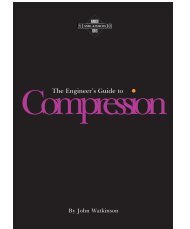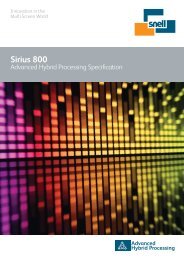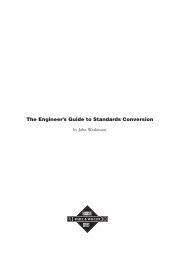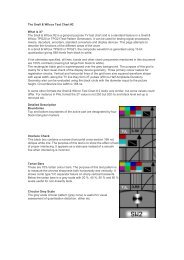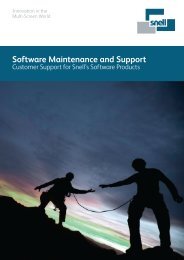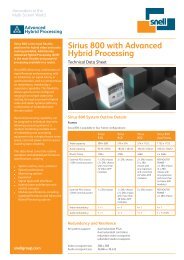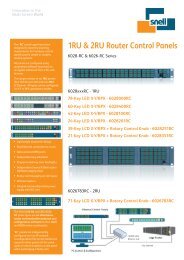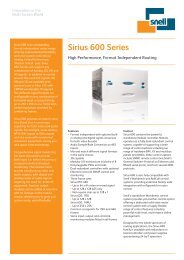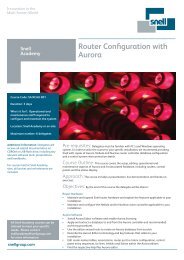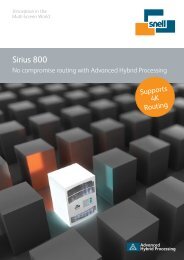Motion compensated frame rate conversion - White Paper - Snell
Motion compensated frame rate conversion - White Paper - Snell
Motion compensated frame rate conversion - White Paper - Snell
Create successful ePaper yourself
Turn your PDF publications into a flip-book with our unique Google optimized e-Paper software.
Innovation in the<br />
Multi-Screen World<br />
<strong>White</strong> <strong>Paper</strong><br />
<strong>Motion</strong> Compensated Frame Rate<br />
Conversion<br />
Paola Hobson, <strong>Snell</strong> Ltd<br />
8 th February 2013<br />
Introduction<br />
<strong>Motion</strong> <strong>compensated</strong> <strong>frame</strong> <strong>rate</strong> <strong>conversion</strong> has proven to be<br />
of great benefit to broadcasters, content owners and media<br />
organizations around the world. The superior quality of motion<br />
<strong>compensated</strong> <strong>frame</strong> <strong>rate</strong> <strong>conversion</strong> allows viewers everywhere to<br />
enjoy pristine pictures which in turn enable broadcast and media<br />
organizations to enjoy international sales of their content.<br />
In this <strong>White</strong> <strong>Paper</strong> we describe some of the technologies used in<br />
motion <strong>compensated</strong> <strong>frame</strong> <strong>rate</strong> <strong>conversion</strong>, and discuss the balance<br />
of cost and quality which customers need to consider when choosing<br />
a converter.<br />
Frame <strong>rate</strong> <strong>conversion</strong> : motion estimation<br />
As viewers and subscribers demand ever-higher quality in their SD,<br />
HD, and 3D content, the quality of the source material is more<br />
important than ever before. Frame <strong>rate</strong> and format <strong>conversion</strong>s are<br />
needed by any content broadcaster or distributor when the content<br />
arrives at a different <strong>frame</strong> <strong>rate</strong> and format than is required for<br />
transmission or distribution to end users. For example, European<br />
HD 50Hz format programs need to be converted to 59.94Hz for<br />
distribution in the US. TV content at 50 or 59 Hz needs to be<br />
converted to 23.98 Hz for DVD and Blu-ray distribution.<br />
Changing the <strong>frame</strong> <strong>rate</strong> of the content essentially means creating<br />
additional <strong>frame</strong>s where none existed at the input. Similarly,<br />
changing the number of lines in the picture (e.g. as in a 720 to 1080<br />
<strong>conversion</strong>) requires creating additional lines where none existed<br />
at the input. Simple linear interpolation of new lines or <strong>frame</strong>s from<br />
those immediately preceding and following gives a very blurred<br />
result when the objects in the scene move, as shown in Figure 1.<br />
Other effects can also arise such as motion judder, where objects no<br />
longer have smooth motion from <strong>frame</strong> to <strong>frame</strong>.<br />
Figure 1 : simple linear standard <strong>conversion</strong><br />
© 2013 <strong>Snell</strong>
Innovation in the<br />
Multi-Screen World<br />
Input <strong>frame</strong> 1<br />
Interpolated <strong>frame</strong>s<br />
Figure 2 : illustration of motion-<strong>compensated</strong> <strong>frame</strong> <strong>rate</strong> <strong>conversion</strong>.<br />
Originally launched in 1994, <strong>Snell</strong>’s Alchemist was the world’s first<br />
motion-<strong>compensated</strong> standards converter. In very simple terms, in<br />
a motion <strong>compensated</strong> converter, the system calculates the motion<br />
between <strong>frame</strong>s in the content, and works out where to move<br />
objects to when creating new <strong>frame</strong>s in between, as shown in Figure<br />
2.<br />
In practice, the simple linear motion shown in Figure 2 is rare, and<br />
motion is often much more complex. Typical video scenes contain<br />
multiple objects, of different sizes moving at different speeds, which<br />
could have very complex shapes. The objects may be passing across<br />
detailed backgrounds, and may cross each other. Therefore accu<strong>rate</strong><br />
calculation of motion is very challenging and different motion<br />
vectors are required for different parts of the picture.<br />
The most accu<strong>rate</strong> motion estimation method developed so far is<br />
called Phase Correlation (Ph.C). Ph.C is used in Alchemist Ph.C-HD<br />
to deliver the highest-quality output with sharp detail, free from<br />
artefacts. Figure 3 shows the results of <strong>frame</strong> <strong>rate</strong> <strong>conversion</strong> using<br />
phase Correlation, yielding perfect output.<br />
Phase Correlation provides a correlation surface from the<br />
comparison of images. This enables the identification of motion on<br />
a pixel-by-pixel basis for correct processing of each motion type.<br />
Since phase correlation ope<strong>rate</strong>s in the frequency rather than the<br />
spatial domain, it is able to zero in on details while ignoring such<br />
factors as noise and grain within the picture. In other words, the<br />
system is highly tolerant of the noise variations and rapid changes in<br />
luminance levels that are found in many types of content – resulting<br />
in high-quality performance on fades, objects moving in and out of<br />
shade, and light flashes.<br />
Frame <strong>rate</strong> <strong>conversion</strong>: the difficult bits<br />
<strong>Motion</strong> estimation is only a part of the processing needed when<br />
<strong>frame</strong> <strong>rate</strong> converting video. Movies and TV programs are<br />
composed of multiple sequences which are edited together, with<br />
various effects such as cuts, fades etc, and often graphics, logos<br />
and text appear over the content for short periods of time (e.g.<br />
a scoreboard) then disappear. Scrolling captions are also very<br />
common, not just at the start or end of a program, but also during a<br />
program to provide instant updates e.g. a stock ticker at the foot of<br />
a news program.<br />
In such cases new content appears in the picture without any<br />
history, and as we explained above, the simple example of Figure<br />
2 is not very common in practice. Therefore motion <strong>compensated</strong><br />
<strong>frame</strong> <strong>rate</strong> converters also have to include processing which<br />
creates perfect picture content in areas where new objects appear,<br />
disappear or obscure each other.<br />
Figure 3 : standards <strong>conversion</strong> using Phase Correlation<br />
Another area where motion estimators have problems is where<br />
the picture contains stationary repetitive patterns, which may be<br />
interpreted as a moving object. In the example shown in Figure 4a,<br />
a motion estimation algorithm examining the scene <strong>frame</strong> by <strong>frame</strong><br />
by looking at an area about the size of one of the bridge supports<br />
(as could be the case for some block-based motion estimation<br />
methods) would have difficulty knowing whether to interpret the<br />
information as a static pattern or a moving object. The moving<br />
bridge support object in Figure 4b could give the same apparent<br />
motion analysis results as the bridge itself (Figure 4a) if it is moving<br />
exactly its own width each <strong>frame</strong>.<br />
© 2013 <strong>Snell</strong>
Innovation in the<br />
Multi-Screen World<br />
Frame 1 Frame 2 Frame 3<br />
Figure 4a : stationary object containing repetitive patterns<br />
Frame 1 Frame 2 Frame 3<br />
Figure 4b : object moving at its own width per <strong>frame</strong><br />
Alchemist Ph.C-HD <strong>conversion</strong><br />
As mentioned above, Alchemist Ph.C-HD uses a highly accu<strong>rate</strong><br />
method called Phase Correlation for calculation of motion vectors.<br />
This is a frequency domain method, which requires spectral analysis<br />
of the content followed by further processing. In Phase Correlation,<br />
the distance and direction of the motion is measured accu<strong>rate</strong>ly, but<br />
the area of the screen in which it took place is not. Thus in practical<br />
systems the phase correlation stage is followed by a pixel-by-pixel<br />
assignment stage.<br />
One reason why phase correlation is so accu<strong>rate</strong> is that it uses<br />
frequency information to calculate the motion in the scene. In this<br />
way, small objects are not missed because they will gene<strong>rate</strong> high<br />
frequency components in the analysis. A further advantage of<br />
phase correlation is that it is sub-pixel accu<strong>rate</strong>, meaning that object<br />
movement in fractions of pixels can be calculated. This leads to<br />
smoother motion profiles and higher quality results.<br />
In addition to highly accu<strong>rate</strong> motion estimation, Alchemist Ph.C-<br />
HD integ<strong>rate</strong>s many additional steps to manage the difficult cases<br />
we described above such as obscured/revealed areas, stationary<br />
repetitive patterns, and highly complex motion. After calculation<br />
of the initial motion vectors, Alchemist Ph.C-HD applies processing<br />
to check for consistency of vectors, discarding those that appear to<br />
be erroneous or not fitting the pattern of vectors in the surrounding<br />
area. Through such techniques, Alchemist Ph.C-HD can avoid errors<br />
often associated with motion <strong>compensated</strong> <strong>frame</strong> <strong>rate</strong> converters<br />
such as blurring or introduction of the wrong content into an area of<br />
the scene.<br />
As may be expected, the additional algorithms and methods used in<br />
Alchemist Ph.C-HD to get such accu<strong>rate</strong> results require considerable<br />
processing resources, and as a result, the Alchemist Ph.C-HD is<br />
a relatively expensive solution. However, the investment cost in<br />
Alchemist Ph.C-HD is rapidly repaid through its unmatched quality<br />
of <strong>conversion</strong> and its handling of difficult program material.<br />
KudosPro<br />
The KudosPro range of motion <strong>compensated</strong> converters (MC500,<br />
MC1000 and MC2000) offers cost-effective <strong>conversion</strong> in a 1U<br />
<strong>frame</strong>. In order to reduce the amount and cost of components used,<br />
KudosPro products use a different processing method to Alchemist<br />
Ph.C-HD.<br />
KudosPro MC500/MC1000MC2000 perform motion estimation<br />
using a special transform analysis which is proprietary. The<br />
transform is designed to detect the broad motion profile of a scene<br />
and is followed by further processing stages to maximise accuracy<br />
and reduce the impact of signal noise.<br />
KudosPro processing was designed to achieve high quality<br />
<strong>conversion</strong>s while keeping the overall processing latency as low<br />
as possible. Even with challenging content, the KudosPro MC500/<br />
MC1000/MC2000 deliver optimal results whilst saving power and<br />
resources through the use of sophisticated analysis techniques.<br />
Conversion results<br />
Both Alchemist Ph.C-HD and KudosPro MC500/1000/2000 offer<br />
good quality <strong>conversion</strong> for a range of typical content. Many types<br />
of content such as news, drama, current affairs and talk shows<br />
contain relatively large objects with slow, regular motion, which does<br />
not challenge a <strong>frame</strong> <strong>rate</strong> converter.<br />
Where motion becomes faster, more complex, and where there are<br />
multiple small moving objects in the scene, the requirements placed<br />
on the <strong>frame</strong> <strong>rate</strong> converter become more demanding. Particularly<br />
difficult are fast action sports and music clips where there are rapid<br />
dance movements.<br />
Figure 5 shows an example where Alchemist Ph.C-HD and KudosPro<br />
MC1000 were used to <strong>frame</strong> <strong>rate</strong> convert some mainly static and<br />
slow moving content. As can be seen in the figure, the content is<br />
sufficiently non-challenging for there to be no visible difference<br />
between the two outputs.<br />
© 2013 <strong>Snell</strong>
Innovation in the<br />
Multi-Screen World<br />
(a)<br />
(b)<br />
Figure 5 : (a) Alchemist Ph.C-HD (b) KudosPro <strong>conversion</strong> of HD content 1080 50i to 1080 59i<br />
However, in the case of more challenging content with fast<br />
movement, as illust<strong>rate</strong>d in Figure 6, we can see that the background<br />
stationary objects look largely similar between the two converters.<br />
However more complex processing capability of Alchemist Ph.C-<br />
HD leads to better rendition of the fast moving objects such as the<br />
motorbike and cyclist.<br />
Figure 6 : (a) Alchemist Ph.C-HD (b) KudosPro <strong>conversion</strong> of HD content 1080 50i to 1080 59i<br />
Conclusions<br />
Both Alchemist Ph.C-HD and KudosPro motion <strong>compensated</strong> <strong>frame</strong><br />
<strong>rate</strong> converters offer state-of-the-art processing, with <strong>conversion</strong><br />
quality unmatched by any other converter in the market. Incredibly<br />
accu<strong>rate</strong> processing combined with years of refinement make<br />
Alchemist Ph.C-HD the true “gold standard” in <strong>frame</strong> <strong>rate</strong> <strong>conversion</strong>,<br />
where converted output is virtually indistinguishable from the input<br />
for most content.<br />
KudosPro uses simpler processing in order to offer a cost-effective<br />
and compact alternative. Good quality results are obtained for<br />
most types of content, but for the most demanding content, such as<br />
sports and dance, Alchemist Ph.C-HD gives better results.<br />
Further reading<br />
For more detail on phase correlation and other motion<br />
estimation methods, please see “The Engineer’s Guide to <strong>Motion</strong><br />
Compensation” by John Watkinson http://www.snellgroup.com/<br />
documents/engineering-guides/emotion.pdf<br />
© 2013 <strong>Snell</strong>



